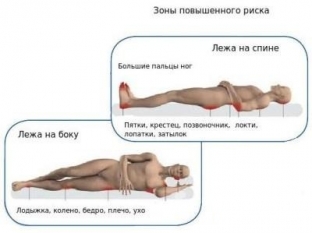Pressure sores that occur in patients who, for various reasons, are forced to lie down for a long time or be limited in movement, cause many problems, since they bring pain and tissue necrosis to the patient, can lead to damage to muscles and bones, be complicated by a bacterial infection and the development of sepsis. In order to avoid the occurrence of bedsores, the bed patient should receive careful special skin care. Pressure sores that appear should be treated immediately to prevent complications.
Causes of bedsores and risk factors
Decubituses are the death of tissues caused by prolonged pressure on them and impaired blood circulation in this place. The main cause of bedsores is tissue compression between the bone and a hard surface (bed, wheelchair): this disrupts blood circulation in small vessels, the cells in this area stop receiving oxygen and nutrition, the tissue dies.
Additional factors that provoke bedsores are friction (against clothes, bedding fabric) and slipping (on a bed, chair). Bed sores are also due to uneven or tight dressings for fractures and even on the mucous membrane due to ill-fitting dentures. Most often, bedsores develop in patients who are forced to move little due to operations, injuries, serious illnesses, due to general weakness, paralysis.
Factors that increase the risk of pressure ulcers in patients:
- old age;
- violation of skin sensitivity in neurological diseases, impaired consciousness (the patient does not feel discomfort on the skin);
- diseases that impair blood circulation (diabetes mellitus, acute vascular occlusion);
- muscle atrophy, wasting, muscle spasms;
- lack of fluid in the body, poor nutrition of the patient;
- too dry or moist skin (including incontinence of urine and feces, excessive sweating).
Types of bedsores, their typical symptoms and localizations
Decubituses are classified into four types depending on the severity of the skin lesions. The first stage is characterized by reddening of the skin, its irritation and hypersensitivity.
The second one is characterized by damage to the epidermis and the appearance of a superficial wound. Third - there is already tissue necrosis throughout the entire depth of the dermis and subcutaneous fatty tissue. The extreme stage of a bedsore is the spread of necrosis to the muscles and bones. In addition, bedsores vary in size, from small to gigantic.
 The sacrum, the back of the head, the heels, the area of the shoulder blades and the buttocks are most often affected. In the initial stages of the disease, debilitated patients may not feel pain. Therefore, a bedridden patient should be regularly and carefully examined by a doctor.
The sacrum, the back of the head, the heels, the area of the shoulder blades and the buttocks are most often affected. In the initial stages of the disease, debilitated patients may not feel pain. Therefore, a bedridden patient should be regularly and carefully examined by a doctor.
Treatment of pressure ulcers and possible complications in the absence of therapy
The principles of pressure sore treatment are reduced to restoring blood flow in the compressed area, rejection of necrotic tissues and wound healing. Pressure sores are treated with special preparations that contribute to the rejection of necrotic masses, or are cleaned with tools. It is recommended to apply dressings with alginates, wound healing agents, when a bacterial infection is attached - antibiotics and antiseptics are used.
The most formidable of the possible complications of a bedsore is sepsis, when bacteria are carried by blood flow throughout the body from an infected pressure sore. Bedsores can provoke phlegmon and purulent arthritis if they are chronic and do not heal for a long time - skin cancer is likely to develop.






Add a comment